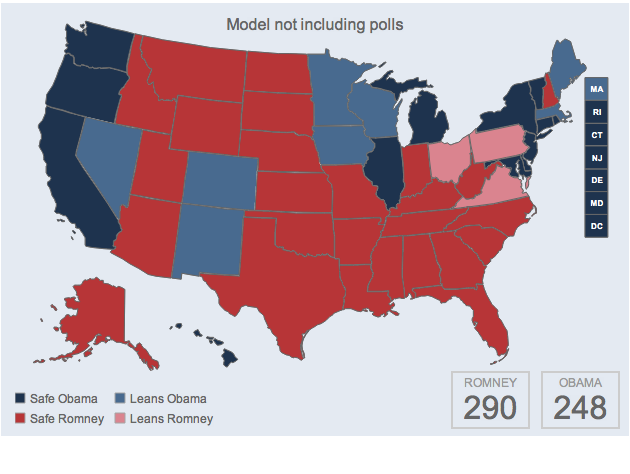All signs point to a Romney victory except one (a very big one)
When you squint your eyes and look only at the broad historical trends at play in this presidential election, all signs point to a victory for Mitt Romney in November.
Back in February, the Signal's first draft of its elections model, which relied only on historical data, predicted that Obama would win the election with 303 electoral votes. This model relies heavily on economic indicators and was published before the dismal second quarter economic figures. If you apply that same model through June, Romney wins with 290 electoral votes to Obama's 248:

The upcoming issue of the peer-reviewed PS: Political Science & Politics includes two models from other researchers that reach the same conclusion. One study by a pair of University of Colorado political scientists, announced yesterday, predicts that Romney will walk away with 320 electoral votes on the back of high unemployment. A second study, by Douglas Hibbs, concludes Obama's weakness includes the death toll in Afghanistan.
I have serious reservations about both papers; for example, our methodology is very conclusive that recent movement in economic indicators correlate with election outcomes, not the overall levels. But I will not subject the readers to the brutal crossfire of warring presidential forecasters. The point is that all of these fundamental models point in the same direction: Romney. And as of today, they are all wrong. That is, all these models look at only half the picture and are not useful today as standalone forecasts.
Those of us in the business of predicting elections rely on two broad sets of data: what has happened in the past, and what polls and markets suggest will happen in the future.
In a perfectly ordered society, in which humans acted in reliably rational ways and researchers had access to complete data on every possible influence, making a model like the ones above might be sufficient to predict an election. In reality, models are about as good as those governing where soon-to-be Hurricane Isaac may or may not land: They can point in the general direction, but they can't predict exactly how the dice will fall. The best possible prediction engine factors in both these broad factors and the forward-looking polls and markets that contribute clarity.
Our updated model, which does factor in polls and markets, still has Obama winning the election with 303 votes:

We searched for an explanation for difference by looking for data points that are uniquely different this year than in the historical elections. There is one glaringly obvious factor: the favorability difference between Obama and Romney.
Favorability is shockingly bad for Romney. Pollsters routinely ask questions like, "Do you have a favorable or unfavorable impression of …" for both Obama and Romney. Currently, the Pollster average has Obama with 48 percent favorability and 45 percent unfavorability, while Romney is lingering with 41 percent favorability and 47 percent unfavorability. Romney's consistent negative favorability to unfavorability split is unprecedented in American politics.
There is a lot of chatter about the value of modern conventions, which are more like pageants than actual nominating events. With the premium on likability in this election, they are still clearly a valuable opportunity to showcase the candidates. It may be Romney's best hope of turning around those favorability polls, which in our opinion are presently costing him the election.
This is going to be interesting! Follow along in real time with PredictWise.com.
David Rothschild has a Ph.D. in applied economics from the Wharton School of Business at the University of Pennsylvania. Follow him on Twitter @DavMicRot and email him at thesignal@yahoo-inc.com.

